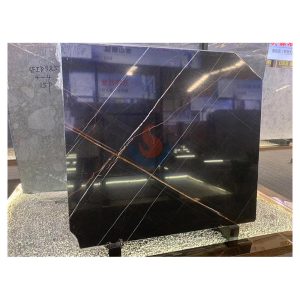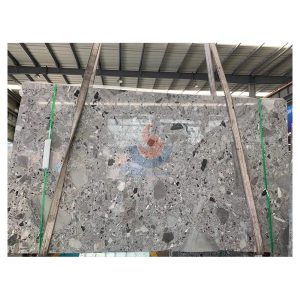Marble, this ancient and noble building material, has become the darling of architecture and interior decoration around the world with its unique texture, color and texture. From Taiwan’s snowflake green to Spain’s champagne red, each type of marble has its own unique charm and application considerations, bringing natural beauty to modern space.

Tunisian Nero Sahara Black Marble St.Laurent Gold Marble Stone Floor Tile
Snowflake green
Originated from Taiwan, China, this stone is natural marble, widely used in the decoration of various buildings such as hotels at home and abroad. Main features, dark green base color, white flowers, brittle material, easy to glue and repair.
Snowflake green defects:
1. Large color difference
2. Large area of white flowers or black spots
3. Yin and Yang colors
4. Cracks, easy to break, easy to deform
Golden Tianlong
Originated from Spain, this stone is natural marble, widely used at home and abroad, such as Beijing Hotel and other major projects have used this material. This material has a yellow base color, general lightness, easy to glue and repair, strong water absorption, and beautiful
Defects:
1. Large color difference, thick rust lines, thick gray lines, and serious damage to the decorative effect
2. Soft, easy to break, severely deformed, cracks, uneven distribution of patterns, yin and yang colors, holes.
Orange Peel Red
Origin: Philippines, this kind of stone is naturally marble, bright color, and unique, leaving a special feeling, dark color, white flowers, crack lines all over, good gloss, easy to glue, the redder the better, less white flowers, uniform color distribution, no black spots, green spots, particularly large color difference, large patterns, easy to break.
Coral Red
Origin: Spain
Features: orange color, uniform white tendons on the board surface, good gloss, easy to glue.
Point: The board sometimes has color spots, color lines, and too many white tendons, which seriously affect the decorative effect.
Suitable for stone crafts: such as door covers, lines, handrails, a small amount of ground and interior walls, etc., large-scale use, and some construction sites with strong color opposition.
Royal Gold
Origin: Israel. This stone is soft and absorbent. It is widely used for interior walls, floors and various special-shaped materials.
This mine has obvious straight lines. Because of its soft texture, it is mostly used for carvings. The mine has obvious color difference. The large-scale projects include Shanghai Marriott Hotel. Its decorative effect fully reflects the brilliant effect of this variety of stone under the light.
Origin: Israel. This stone is soft and absorbent. It is widely used for interior walls, floors and various special-shaped materials.
This mine has obvious straight lines. Because of its soft texture, it is mostly used for carvings. The mine has obvious color difference. The large-scale projects include Shanghai Marriott Hotel. Its decorative effect fully reflects the brilliant effect of this variety of stone under the light.
Golden Mocha
Origin: Philippines
This mineral material is hard, wear-resistant and has good lightness. Its physical properties are relatively stable. Because its color and texture are relatively flamboyant, it is generally not used in a large area. It is suitable for wave beating and some grid strips and door frames, service desks and special-shaped materials.
Beige Travertine
Origin: Iran, with lower price; also produced in Italy, with higher price.
This kind of stone structure has similar characteristics, loose stone structure, large holes, and messy texture.
But now the architectural fashion in the world tends to be European and American antique beauty, and the selected designs have changed a lot. It can be used to process columns, external and internal walls, but not suitable for the ground. The processing method can be selected as glue filling or no glue filling:
1. No glue filling;
2. Glue filling: Glue filling can be divided into transparent glue filling, yellow and white glue filling, A and B glue filling.
Red Travertine
Origin: Turkey. It has strong texture and unique style. It is more popular abroad and less used in China. The stone board has more holes and is used for exterior wall skirts and interior walls.
Asia Beige
Origin: Turkey
This stone belongs to marble and has some characteristics of Golden Flower Beige, such as yellowish base color, similar patterns, and grain direction, but its pattern is larger than that of Golden Flower Beige, with obvious color lines, and white spots are extremely unstable. It is more suitable for interior walls, floors, and bathrooms. In addition to the glossy effect, the antique surface and acid-washed surface are also good.
HP Beige
Origin: Turkey
There are two types: straight grain and random grain. Therefore, when opening up the waste material, you should pay attention to the grain direction. The effect of its grain and random grain is somewhat similar to the straight grain and random grain of Silver Line Beige. The light effect of this board is not ideal, it is difficult to polish, the board surface is unstable, sometimes the black grain is more concentrated, and the places where the black grain is concentrated often have many holes, which need to be repaired with glue. This board is very fragile.
Xishi Red
Origin: Spain
The base color is golden orange red or light orange red, with good brightness and easy to repair with glue. If there are obvious grains on the entire board, it will not be obvious. The color difference of this board is particularly large, the pattern is unstable, there are many cracks, the board surface has white spots, white lines, yin and yang lines, black lines, black spots, green spots and other defects, and shell fossils can be seen on its surface.
It is more suitable for interior walls, floors, door frames, columns, etc. Typical projects include Xinjiang Jinsui Building, etc.
Wanshou Red
Origin: Italy
The base color is dark red, with a circular pattern, average brightness, easy to glue, color difference, and a relatively stable pattern, but there is often uneven distribution. The material is loose and the density is uneven. When the red strips and circular patterns are crisscrossed, it will destroy its decorative effect. There are yin and yang colors. The board surface often appears red concentrated in one piece, white concentrated in another piece, and there are light yellow tendon lines.
It is more suitable for decorative parts such as mosaics, but not for exterior walls.
Champagne red
Origin: Spain
The board surface is light orange-red with crack lines, good gloss, and easy to glue. The board has color difference, large cracks, and is easy to break and crack. Because of the color difference, it looks white in some parts. Because the board surface material is loose, it is not suitable for exterior decoration. At the same time, the board is easy to fade.
It is more suitable for interior walls, floor mosaics and other decorative parts. It is not suitable for large areas and exterior walls because it is easy to fade and weather.
Net pattern large flower white
Origin: Italy
Net pattern large flower white, as the name suggests, is a white stone with a net-like pattern. Its base color is white and has gray net or strip patterns.
This stone is natural marble, which is widely used for exterior and interior decoration of pavilions and pavilions at home and abroad. It has good gloss and is difficult to glue. The following points should be noted when using it:
1. Because it is a white stone, it is easy to be contaminated. It is best to stain the back of the stone during installation.
2. Pay attention to the grain when installing, otherwise it will be messy and affect the effect.
3. This stone can be wet-pasted, if dry-hanging, a plate with a thickness of more than 25mm is required.
Beijinsha
Origin: France; also known as Jinsha Stone
This stone is a natural sandstone stone, widely used for the interior and exterior walls of buildings. It is a medium-to-high-end stone.
This type of stone is beige, and its water absorption rate is relatively low compared to other sandstones. It is used to decorate the wall with a matte or rough surface, showing a simple effect. This type has been used in Shanghai Jinye Building in China, mainly used on walls and door frames.
This stone can be wet-pasted or dry-hanged, and the color will not become significantly darker after absorbing water, so you can use it with confidence.
Cream Sandstone
Origin: Spain; also known as Beisha Gold
It is a natural sandstone stone with a specific gravity of 2200KG/M3, generally used for exterior and interior decoration. Cream sandstone is golden in color, with obvious bright colors and holes. When used in buildings, it can show the main body of the sea and stone. The business department of China Construction Bank’s Hubei Provincial Branch has widely used this stone for interior walls and door frames.
Cream sandstone has strong air permeability, high water absorption, and lighter color. It should generally be treated with anti-fouling and can only be dry-hung during installation.
Australian sandstone
Origin: Australia
This stone belongs to natural sandstone, with a specific gravity of 1800KG/M3, and is generally used for exterior decoration. Australian sandstone is dark yellow in color and has fine holes. When used in buildings, it can show a solemn and simple appearance. This type of stone has fine and obvious patterns, and it is necessary to pay great attention to the direction of the texture.
In general, stone can only be used for dry hanging. Because of its loose structure and light specific gravity, the thickness of the dry hanging board is generally controlled to be more than 30mm thick to ensure safe installation. In addition, try to do waterproof and anti-fouling treatment.

Natural Terrazzo Fossil Grey Marble Big Slab Engineered Size Marble
The diversity of marble makes it a treasure in the decoration world, but the unique properties of each stone also bring different application challenges. Understanding the characteristics, advantages and disadvantages of each marble and the appropriate maintenance methods are essential to ensure its beauty and durability in decoration. Reasonable selection and careful maintenance can make these natural works of art shine more lastingly in modern homes and buildings.





